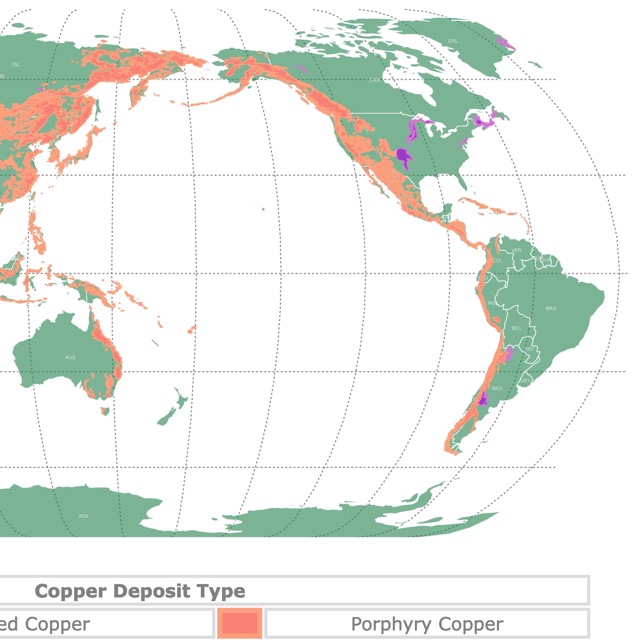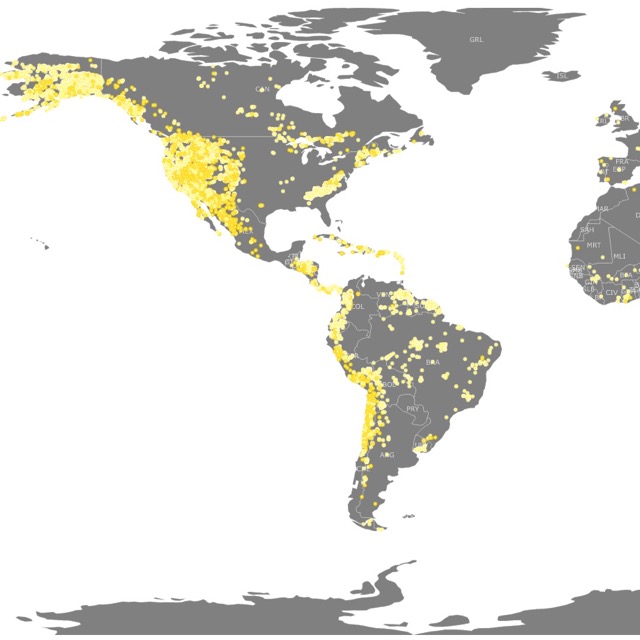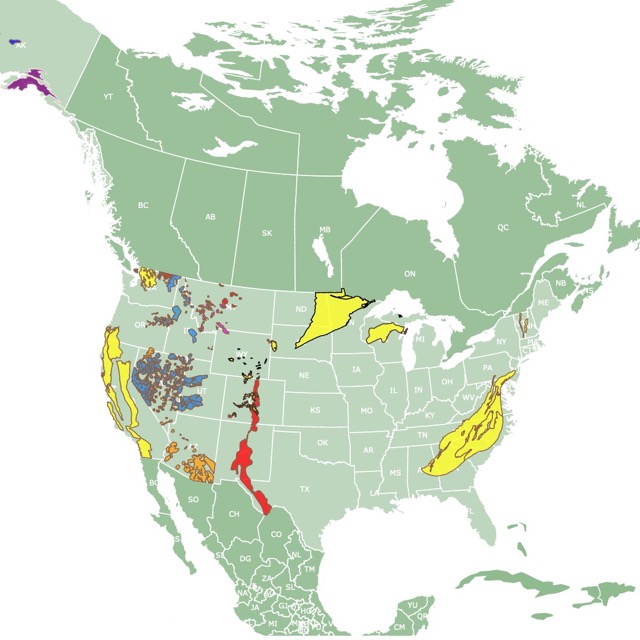Map of Nickel Deposits Worldwide
This map depicts World Nickel Deposits in purple and blue. For more detail, hover over the map. To take a closer look, zoom in. For more information, scroll down.
| Key | |||
|---|---|---|---|
| Nickel (NI) | Nickel and other metals AU (gold), CU (copper), FE (lead), ZN (zinc) | ||
NICKEL
Nickel is a chemical element with the symbol Ni and atomic number 28. It is a silvery-white, malleable, hard, and ductile metal widely used in various industrial and consumer applications.
Nickel is corrosion-resistant and therefore used in stainless steel. It also has high strength and heat resistance.
Nickel is ferromagnetic at room temperature, like its periodic table neighbors iron and cobalt.
Most nickel compounds are blue or green.
If you think its time to invest in metals, or other commodities, Acorns app can help. Acorns helps you invest spare change, bank smarter, and build wealth through long-term investing. To start today, Sing up here!
Nickel Uses and Properties
Nickel is primarily used to produce stainless steel, accounting for around 70% of its total consumption.

Nickel is used in coins. The U.S. five-cent coin is known as a nickel! It is 25% nickel and 75% copper.
Nickel is used in batteries, including rechargeable batteries used in hybrid vehicles. This is of great importance because Electronic Vehicles use it, and it is a major driver for greener energy sources.
It is also used in the producing various other alloys, such as nickel-copper, nickel-chromium, and nickel-molybdenum, used in applications ranging from electrical wiring to aerospace components.
Another use of nickel is as a catalyst in chemical reactions.
Nickel is the main element in Mu-metal. This is a metal that shields other metals from magnetic attraction. It is made of 80% nickel and 20% iron.
Another notable use of nickel is in Nitinol. Nitinol is a 1:1 nickel-titanium alloy. This alloy remembers its previous shape when heated.
Before the creation of rare-earth magnets like neodymium-iron-boron, the strongest magnets were made from a nickel alloy: mainly aluminum, nickel, cobalt, and iron.
If you like collectibles and are interested in having one of many elements of the periodic table, Amazon has the Nickel Cube Block Display. This is a 10mm pure metal Ni cube. The symbol, density, and atomic number printed on its surface.
Natural Abundance of Nickel
Nickel is the fifth most abundant element on Earth. It is 100 times more concentrated below the Earth’s crust than in it.
If you want to learn more about nickel, Amazon has The Winning of Nickel: Its Geology and Mining. A hardcover book on this versatile element.
Most mined nickel comes from two types of ore deposits:
Magmatic Sulfide Deposits
Magmatic sulfide deposits are the principal ore mineral of pentlandite [(Ni,Fe)9S8].
"Magmatic nickel sulfide deposits form when magmas derived from the Earth’s mantle ascend into the crust, in some cases reaching the Earth’s surface, and crystallize into iron-magnesium-nickel-rich mafic and ultramafic rocks containing concentrations of Ni-rich sulfide minerals".
Laterites
Laterites, where the principal ore minerals are nickeliferous limonite [(Fe,Ni)O(OH)] and garnierite (a hydrous nickel silicate). Laterite-hosted nickel deposits form by the weathering of ultramafic rocks and are near the surface.
In some deposits, the Ni is associated with concentrations of platinum-group elements (PGEs) and copper, which increase the value of the nickel ore deposits. Source: Geoscience Australia.
You will find some of these PGE's as you hover over the map above.
Other Natural Sources of Nickel
Nickel is present in metallic meteorites. Iron is the most abundant element in metallic meteorites, followed by nickel. Source: Chemicool.
A large amount of the nickel on Earth arrived with meteorites. One of these meteorites landed in the region near Ontario, Canada.
This region is responsible for about 15% of the world’s production.
Extensive nickel resources also are found in manganese crusts and nodules on the ocean floor.
Learning about mining and metals does not make you richer, but buying and selling stocks will. Round up the purchase of everything you spend, up to the nearest dollar. Acorns will help you invest it. Download the app here!
Nickel Reserves
According to the USGS, there are around 94 million tonnes of known nickel reserves globally.
Indonesia's Nickel Reserves
Indonesia holds 21 million tonnes of nickel and is home to 22% of the world's reserves.
This was the world's top producer until the production fell in 2020. Its production that year was 760,000 tonnes.
Australia's Nickel Reserves
Australia holds 20 million tonnes of nickel reserves, about 21% of the global share.
Despite its immense reserves, it is only the fifth-largest producing country in the world.
Most of the reserves are located in Western Australia, with most production coming from mines at Mount Keith and Leinster, located north of Kalgoorlie.
Brazil's Nickel Reserves
Brazil has the third most significant nickel reserves worldwide, with 16 million tonnes. Brazil has slowed down the nickel production, but with new technologies, is looking to increase production.
Its major projects include Barro Alto Mine in Goias, Onca Puma Mine in Para, and Santa Rita in Bahia. All of these projects are open mine pits. Source: MT.
Russia's Nickel Reserves
Russia exports most of its 6.9 million tonnes of nickel reserves to Europe.
Russia is also the world's third largest nickel producer after Indonesia and the Philippines. It exports about 280,000 tonnes/year.
Its principal project is in the Norilsk region north of the Arctic Circle in Russia, where some of the world’s largest nickel-copper-palladium deposits are located. Source:
NS Energy.
Nickel Recycling
Given the high costs and environmental harm caused by mining, recycling metals like nickel results in a win-win scenario for the environment and the industry.
Metals are recycled for their value; when recycled, they do not lose their quality. This is especially true for non-ferrous metals like nickel.
About 68% of nickel is recycled. 15% goes to steel, and unfortunately, 17% ends in landfills. The portion not recycled is usually waste from electrical and electronic instruments.
Resources for World Nickel Deposits Map
The shapefiles with Nickel deposits are from U.S. Geological Survey mineral databases; MRDS and MAS/MILS Data Series 52 By: E.J. McFaul, G.T. Mason, W.B. Ferguson, and B. R. Lipin. It can be downloaded from MRDATA.
The Shapefiles with countries were downloaded from Natural Earth.
This map will be updated with new data! To receive updates on this and more nature maps, join my email list!!!!!!!
Made by Luz K. Molina with D3.js.











